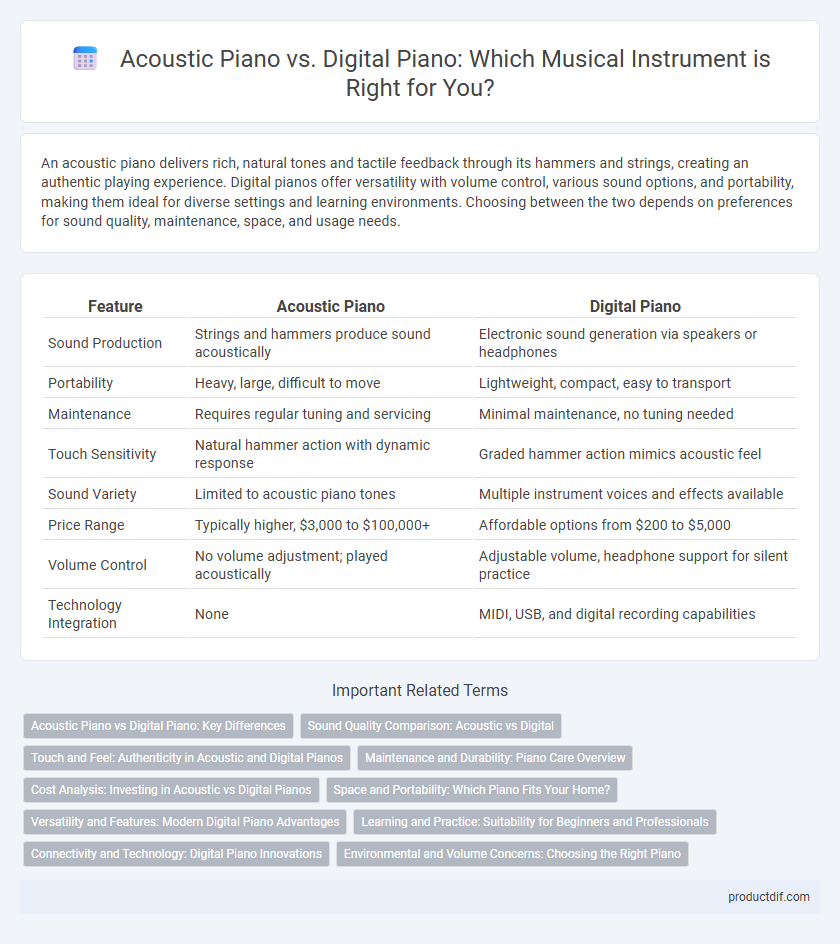An acoustic piano delivers rich, natural tones and tactile feedback through its hammers and strings, creating an authentic playing experience. Digital pianos offer versatility with volume control, various sound options, and portability, making them ideal for diverse settings and learning environments. Choosing between the two depends on preferences for sound quality, maintenance, space, and usage needs.
Table of Comparison
| Feature | Acoustic Piano | Digital Piano |
|---|---|---|
| Sound Production | Strings and hammers produce sound acoustically | Electronic sound generation via speakers or headphones |
| Portability | Heavy, large, difficult to move | Lightweight, compact, easy to transport |
| Maintenance | Requires regular tuning and servicing | Minimal maintenance, no tuning needed |
| Touch Sensitivity | Natural hammer action with dynamic response | Graded hammer action mimics acoustic feel |
| Sound Variety | Limited to acoustic piano tones | Multiple instrument voices and effects available |
| Price Range | Typically higher, $3,000 to $100,000+ | Affordable options from $200 to $5,000 |
| Volume Control | No volume adjustment; played acoustically | Adjustable volume, headphone support for silent practice |
| Technology Integration | None | MIDI, USB, and digital recording capabilities |
Acoustic Piano vs Digital Piano: Key Differences
Acoustic pianos produce sound through hammers striking strings, offering rich tonal depth and natural resonance, which digital pianos replicate using sampled sounds and speakers. The tactile response of an acoustic piano's weighted keys provides expressive control, whereas digital pianos feature adjustable touch sensitivity and various instrument voices. Maintenance requirements distinguish them, with acoustic pianos needing regular tuning while digital models require minimal upkeep and often include recording and connectivity features.
Sound Quality Comparison: Acoustic vs Digital
Acoustic pianos produce rich, resonant tones through natural vibrations of strings and soundboard, offering dynamic sound nuances that digital pianos strive to replicate using high-quality sampled sounds and advanced sound modeling technology. Digital pianos provide consistent sound quality unaffected by environmental factors, with customizable tones and volume control, while acoustic pianos depend on physical maintenance and room acoustics for optimal sound. The choice between acoustic and digital pianos centers on the balance between authentic sound richness and modern versatility in sound quality.
Touch and Feel: Authenticity in Acoustic and Digital Pianos
Acoustic pianos offer unparalleled authenticity in touch and feel due to their mechanical action, providing natural resistance and nuanced dynamic control through hammer-struck strings. Digital pianos use weighted keys and advanced sensor technology to emulate this experience, though slight variations in key response and escapement realism can influence playability. High-end digital models incorporate graded hammer actions and escapement simulations to closely replicate the tactile feedback of acoustic instruments.
Maintenance and Durability: Piano Care Overview
Acoustic pianos require regular tuning, humidity control, and occasional repairs to maintain sound quality and structural integrity, with recommended professional servicing every 6-12 months. Digital pianos demand minimal maintenance, primarily involving software updates and occasional cleaning, with virtually no impact from environmental factors like humidity or temperature. Acoustic piano components such as strings and hammers wear over time, while digital models rely on electronic parts with longer lifespans and greater resilience to wear and tear.
Cost Analysis: Investing in Acoustic vs Digital Pianos
Acoustic pianos typically demand a higher initial investment ranging from $3,000 to $100,000 depending on brand and size, alongside ongoing maintenance costs such as tuning and repairs. Digital pianos offer a cost-effective alternative with prices between $500 and $5,000, requiring minimal upkeep and no tuning expenses. The long-term value of acoustic pianos may appreciate due to craftsmanship, while digital pianos provide budget-friendly accessibility and versatility ideal for beginners and casual players.
Space and Portability: Which Piano Fits Your Home?
Acoustic pianos require significant space due to their large frames and are heavy, making them challenging to move within a home. Digital pianos offer a compact design and lightweight build, ideal for small spaces and easy portability. Selecting the right piano depends on your available room dimensions and how often you plan to relocate the instrument.
Versatility and Features: Modern Digital Piano Advantages
Modern digital pianos offer extensive versatility with features such as multiple instrument voices, built-in metronomes, and connectivity options like MIDI and USB, enabling seamless integration with music production software. Their compact design and volume control allow practice in various environments without disturbing others, unlike traditional acoustic pianos. Advanced digital models also provide customizable touch sensitivity and recording functions, enhancing both learning and performance experiences.
Learning and Practice: Suitability for Beginners and Professionals
Acoustic pianos offer authentic touch sensitivity and dynamic response ideal for developing advanced finger control, making them preferred by professionals for nuanced practice. Digital pianos provide adjustable volume, headphone compatibility, and built-in metronomes, enhancing convenience and focus during beginner lessons. Both instruments support structured learning, but digital pianos often include interactive features and connectivity for digital learning tools benefiting early-stage musicians.
Connectivity and Technology: Digital Piano Innovations
Digital pianos offer advanced connectivity options including USB, MIDI, and Bluetooth, enabling seamless integration with computers, tablets, and music production software. Unlike acoustic pianos, digital models often feature built-in recording capabilities, headphone outputs for silent practice, and customizable sound settings that enhance versatility. These technological innovations make digital pianos ideal for modern musicians seeking flexible performance and learning tools.
Environmental and Volume Concerns: Choosing the Right Piano
Acoustic pianos produce natural, rich tones but generate significant volume, which may be unsuitable for noise-sensitive environments. Digital pianos offer adjustable volume levels and headphone compatibility, minimizing noise pollution and making them ideal for urban living spaces. Environmental factors such as the use of sustainable materials and energy efficiency favor digital pianos, as acoustic piano production involves extensive wood and metal resources.
Acoustic Piano vs Digital Piano Infographic

 productdif.com
productdif.com